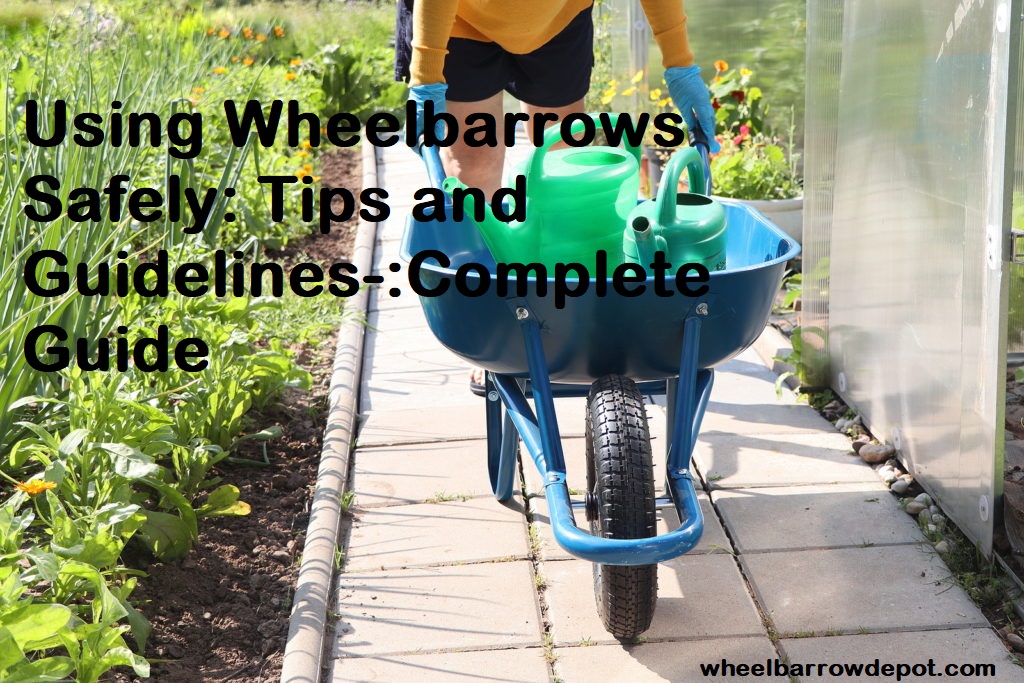Are you concerned about using a wheelbarrow safely? Don’t be. With this guide, you’ll learn the tips and guidelines needed to handle your wheelbarrow with confidence and ease.
Read on to discover how to use a wheelbarrow without causing any accidents or harm!
Wheelbarrow usage is an essential task when performing any kind of construction, gardening, or landscaping work. As such, it is important to be aware of the essentials of using a wheelbarrow safely in order to minimize the risk of injury and maximize efficiency. This guide provides an overview of safe wheelbarrow practices so that users may make well informed decisions while using this versatile piece of equipment.
This guide will cover information such as:
- Wheelbarrow types and features
- Essential safety tips for use
- How to properly lift and maneuver a loaded barrow
- Protective clothing/equipment for operators
- Additional accessories/attachments: what are available
By following these guidelines, users can optimize their performance when working with a wheelbarrow for any activity – from construction work to gardening and landscaping projects.

Types of Wheelbarrows
Selecting the right type of wheelbarrow is essential to keeping your employees and volunteers safe while maneuvering objects. The two main varieties of wheelbarrows are single-wheel and two-wheel handy barrows.
Single-wheel wheelbarrows feature a single wheel in front and are commonly used for construction, small jobs and everyday use because they are easy to maneuver around tight spaces, like those typically found on large construction sites. Two-wheel wheelbarrows have two wheels under the load pan making them easier to manage with heavier loads, but not well suited for tight spaces.
Aside from single or double wheeled wheelbarrow configurations, there are also combiBarrows or all seasons utility vehicles containing a removable telescopic rear axle arm with wheels on either side that offer steadiness when maneuvered over uneven surfaces. Other common varieties include garden carts which typically feature four large wheels and an extended handle for pulling or pushing heavy loads in the garden, plastic models with solid tires that can take rough terrain more efficiently, electric operated models designed for more strenuous tasks requiring less effort by the operator and even narrow treads with extended handles suitable for moving furniture around tight corners indoors or outdoors.
Single-wheel Wheelbarrows
Single-wheel wheelbarrows are most often used for landscaping tasks, such as moving materials from one place to another on a construction site. It is important to use proper lifting and loading techniques to prevent injury or damage. When using a single-wheel wheelbarrow, make sure the box is evenly loaded and that the contents are well distributed. The weight should not exceed the manufacturer’s specifications.
Take care when lifting or pushing the wheelbarrow up and down steps or inclined surfaces, ensure the load is carried close to your body and keep your back straight. The single wheel should roll ahead of you so you don’t overbalance – it may be helpful to use two hands on the handles if you feel unsteady.
If possible, avoid carrying a full load up stairs as this increases the chances of losing control of the wheelbarrow and can cause serious injury or damage. Lastly, take it slow going around corners or maneuvering in tight spaces – using caution will ensure safety for yourself and any bystanders in your vicinity.
Dual-wheel Wheelbarrows
Dual-wheel wheelbarrows are designed specifically to make it easier to move heavy loads up or down a hill or across uneven terrain. They feature larger, counter-rotating rear wheels that grip the ground with increased traction, allowing the front end of the wheelbarrow to be raised without tipping over. A balanced load in a dual-wheel wheelbarrow will make it easier to maneuver even on inclines, as well as track more accurately in a straight line.
When using a dual-wheel wheelbarrow:
- If you’re carrying very heavy loads consider using twin handled barrows with two handles for greater control when pushing uphill.
- Load materials evenly on either side of the wheelbarrow for stability and balance when going over uneven terrain.
- Make sure that you wear proper safety gear such as gloves and eye protection when handling large and/or heavy items in your wheelbarrow.
- Use extra caution when carrying extremely heavy materials over an uneven surface as this may cause the load to shift unexpectedly, leading to accidents.
- If you’re working alone use an extra hand cart or wooden block to help stabilize your load for added stability when pushing/pulling your wheelbarrow up or down hills or steep inclines.
Electric Wheelbarrows
Electric wheelbarrows are a great option for those who need to transport heavy loads over a short distance. They are easy to maneuver and require minimal physical effort to operate. Electric wheelbarrows also provide a safer transport alternative than manual wheelbarrows, as they tend to have fewer tipping hazards.
When using an electric wheelbarrow, you should always understand how it works and how the various parts work together. This can be done by consulting the owner’s manual or speaking with an expert in the field. In addition, consider familiarizing yourself with the following safety tips:
- Always wear protective equipment when operating an electric wheelbarrow, including steel-toed boots, eye protection, hearing protection and a hard hat.
- Ensure that your load is secured properly before beginning operation of the electric wheelbarrow.
- Pay attention to your environment as you maneuver your electric wheelbarrow in tight or crowded spaces; be watchful of people and obstacles that could impede your progress or cause harm if struck by the barrow’s contents.
- If possible, avoid difficult terrains such as slopes or deep mud as this could pose additional risks of tipping or electrical shock from water contact with parts of the machine.
- Always inspect your electric wheelbarrow before each use; this includes checking battery levels, inspecting all wires and cords for damage and confirming that all brakes are functioning properly.
III. Common Mistakes to Avoid
When using wheelbarrows, certain safety precautions must be taken to ensure the task is completed without incident. It’s important to do your research and understand how to use wheelbarrows correctly and safely. Below are some of the most common mistakes made while using wheelbarrows, and how they can be avoided:
Not wearing gloves
Making sure you wear gloves while using a wheelbarrow is an often overlooked component of safe usage. Gloves protect your hands from any sharp objects which may be in the wheelbarrow, and can also provide extra grip to prevent you from dropping the load or losing control.
Not having enough weight in the tray
Wheelbarrows should be loaded appropriately with a reasonable amount of weight—too much weight will make it difficult to maneuver and even potentially cause back injuries from straining too much. On the other hand, if there is not enough weight in the tray it will make it difficult for the wheel to move properly, increasing friction on its axles and potentially causing damage as well as difficulty controlling it when turning.
Filling up too high
When loading items into a wheelbarrow try not to fill it too high; this makes controlling it more difficult and could result in tipping over when going around corners or slopes. Stay below two-thirds full when possible; if you need more capacity consider using two smaller loads rather than overloading one wheelbarrow.
Using incorrect posture
Many people make the mistake of leaning forward when pushing their wheelbarrows—this puts unnecessary strain on your lower back muscles as well as your arms and shoulders making pushing harder work than necessary. To achieve optimal posture for best efficiency, stand upright with arms slightly bent at the elbows so that you’re pushing against, rather than leaning into, the handles. Make sure that your feet are spread shoulder width apart so that you feel steady balanced on two feet instead of leaning off balance with one foot thrust forward at all times as some people tend to do while using a wheelbarrow.

Overloading the Wheelbarrow
When carrying items, it is important to make sure neither the wheelbarrow nor the person handling the wheelbarrow is overloaded. This can be dangerous for both person and machine. Wheelbarrows are generally rated for a certain amount of weight and overload can easily cause the wheelbarrow to become unbalanced and difficult to manage. An overloaded wheelbarrow handle may even break or bend as a result of excessive weight, leading to an injury or spill.
Before lifting any material onto the tray, ensure that you know its weight and that you keep it within safe limits for your body type and experience level. Before beginning work, use a scale such as a bathroom scale or kitchen scale to get an approximate weight of what will be loaded on the tray. The two types of scales may not provide exact measurements but should give you enough information to stay safely within guidelines. Once you have determined your maximum safe load capacity, remember not to exceed it while using your wheelbarrow.
Improper Positioning of the Wheelbarrow
The excessive weight that can be applied to a wheelbarrow can cause it to become unstable and possibly tip when in use. In order to prevent this, the user should always keep their back as vertical as possible while carrying a load and position the wheelbarrow within a comfortable range of motion.
It is also important to ensure that the wheelbarrow’s handle or frame is level or slightly tilted forward. An incorrect positioning could result in an uneven distribution of weight and an eventual collapse when walking in an incline or downhill direction.
Additionally, users should refrain from lifting a heavily loaded wheelbarrow above hip height as doing so will concentrate an amount of force at the lift point, making it more likely for the user to strain themselves when lifting with leverage against gravity.
Maintenance and Storage of Wheelbarrows
Maintenance and storage of a wheelbarrow is an important part of keeping it in good working condition. A well-maintained wheelbarrow will not only last longer, but it will also be more comfortable to use. Here are some tips on proper maintenance and storage:
Greasing: To keep your wheelbarrow rust-free, you should grease all metal parts on a regular basis. This includes the handles, axle, nut, and any other metal components in contact with the ground or the load you are carrying.
Lubrication: To keep your wheelbarrow running smoothly, you should lubricate the axles and track rollers with grease or oil. This will ensure that there is no friction between these surfaces and make it easy for you to maneuver your load without strain or injury.
Storage:Your wheelbarrow should always be stored indoors in a dry area away from direct sunlight or inclement weather conditions. When not in use, cover or store away your wheelbarrow properly to prevent corrosion from water and debris damage. If possible, keep it off the ground—on blocks or a shelf—so that air can circulate around it, further protecting it from rust damage.
Additionally, frequently check the wheels for signs of wear and tear such as splits or cracks on rubber tires and flat spots due to too much weight being placed on one side of the tire while parked.
Cleaning the Wheelbarrow
Cleaning the wheelbarrow is an important step in the process of safely and effectively using it. Regular cleaning and maintenance are necessary to keep the wheelbarrow in optimum working conditions.
To clean the wheelbarrow, start by removing any excess dirt or debris that may have accumulated on its surfaces. A putty knife, a scrub brush and mild cleaners can be used for stubborn spots. After that, rinse off surfaces well with water then dry it thoroughly with a cloth.
It is also important to check all nuts, bolts and screws for tightness, replacing any that are worn or missing. Once that is done, lubricate all of its moving parts with oil or grease. This will ensure smoother operation and help to prevent rust buildup—a common problem in wheelbarrows due to their frequent contact with water and dirt.
For best results, complete this cleaning process at least once a month as part of your regular wheelbarrow maintenance routine.
Storing the Wheelbarrow
When not in use, the wheelbarrow should be stored somewhere dry and out of direct sunlight. It can be stored inside or outside, but it is important to minimize any potential damage from the elements of weather.
For instance, if you are storing it outside, it is important to make sure that the wheelbarrow does not remain exposed to prolonged rainfall for extended periods of time. If you opt for indoor storage, ensure that your room or garage does not suffer from excessive humidity which could cause material degradation over time.
Additionally, if you are storing wooden handles the oils may need replenishing periodically to maintain the integrity and quality of its finish.
Conclusion
In conclusion, wheelbarrows are a useful tool for many tasks, but safety and caution should always be your priority when operating one. Be sure to check the wheelbarrow before use and inspect it for any potential defects such as damaged wheels, handles or general wear and tear. Take extra care if you’re carrying heavy items as these can cause an imbalance in your wheelbarrow, potentially leading to an accident.
Remember to wear protective gear such as thick gloves, shoes with good grip, hats or headgear – anything that can improve your safety. Most importantly, stay alert and don’t forget to have fun!
FAQ’s
What is the proper way of taking care of wheelbarrow?
The proper way to take care of a wheelbarrow is to clean it after each use, store it in a dry place, check the tire pressure, and lubricate any moving parts.
What is the use of a wheelbarrow?
A wheelbarrow is a tool used for carrying and transporting materials, such as dirt, gravel, or construction materials, from one place to another.
How do you protect a wheelbarrow from rust?
To protect a wheelbarrow from rust, you can clean it regularly, dry it thoroughly after use, and apply a coat of rust-resistant paint or a rust inhibitor.
What is the problem of wheelbarrow?
One problem with a wheelbarrow is that it can be difficult to maneuver over rough or uneven terrain, and it can tip over if it is not loaded or balanced correctly.
What is the best position for the wheelbarrow?
The best position for a wheelbarrow is with the handles at waist height and the wheel slightly in front of the user’s feet.
Is using a wheelbarrow manual handling?
Yes, using a wheelbarrow is considered manual handling, and it can pose a risk of injury if not done correctly.
How to do human wheelbarrow step by step?
To do the human wheelbarrow, one person holds the other person’s feet while they walk on their hands, with their body in a horizontal position. The two people then move forward together in this position.
What are some fun facts about wheelbarrows?
The wheelbarrow was invented in China over 2,000 years ago and was originally used for carrying people. It was introduced to Europe in the 13th century and was used for carrying heavy goods and materials.
What is a wheelbarrow short note?
A wheelbarrow is a small hand-propelled vehicle with a single wheel and two handles used to move materials from one place to another.
How do you prevent or remove rust?
To prevent rust, you can keep metal surfaces clean and dry, use rust-resistant paints or coatings, and apply a rust inhibitor. To remove rust, you can use sandpaper, wire brushes, or chemical rust removers.
See more-
- Best 2 wheel wheelbarrow 2023
- Best 4 wheel wheelbarrow 2023
- Best 6 cu ft wheelbarrow 2023
- Best 5 cubic foot wheelbarrow 2023
- Best wheelbarrow for firewood 2023

Richard Tolliver is a seasoned author and the CEO of a popular wheelbarrowdepot and informative website. With a degree in Horticulture from the University of Missouri, he worked as a professional landscaper and garden designer for several years. His website, founded in 2010, offers comprehensive and unbiased reviews of the best wheelbarrows available in the market, helping readers make informed decisions based on their needs and budget. His expertise and knowledge have been recognized by industry professionals, and he continues to inspire gardening enthusiasts and outdoor enthusiasts alike with his personal experiences and tips on creating beautiful and sustainable outdoor spaces.

